Sea Chubs: Family Kyphosidae
Species: Girella nigricans (Ayres, 1860); from the French word girelle (a derivative of julis, an old word used to denote a number of small wrasse in Europe), the Latin word nigr (dark) and the Greek word ikanos (becoming, in reference to its pleasing appearance).
Alternate Names: Blue-eye perch, green perch, opaleye perch, bluefish, blue bass, greenfish, Jack Benny, Catalina perch, button-back, button-eye, and button bass. Called chopa verde in Mexico.
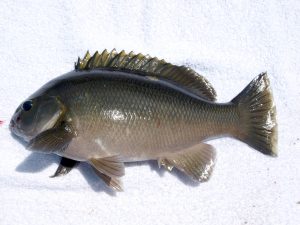
Identification: Opaleye are perch-shaped but heavier bodied. Their coloring is usually dark olive green, usually with two light spots at the base of the dorsal fin; occasionally pale green while some almost all white fish have been observed. Eyes are distinctive: large and an opalescent, blue-green color.
Size: To 26 inches and over 13 pounds. The California angling record fish weighed 6 lbs 4 oz and was taken near Los Flores Creek in Malibu in 1956. Another 6 Lbs 4 oz opaleye was reportedly caught by David Douglas at the Santa Monica Pier in 1964 (Pasadena Independent, January 16, 1964). It was never officially recorded. The diving record fish weighed 13 Lbs 7 oz and was speared by David Williams at Aliso, south Laguna Beach, in 1964. Unfortunately, most opaleye caught from piers are less than 14 inches in length.
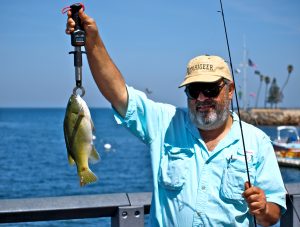
Mahageer (Hashem Nahid) and an opaleye from the Cabrillo Mole in Avalon
Range: Gulf of California (isolated population), and Pacific Coast from Cabo San Lucas, southern Baja California, to Otter Rock, Oregon. Common from Bahia Magdalena, southern Baja California, to Point Conception. Less common north of Point Conception and rare north of Monterey. A resident population does appear to have made a home at the Monterey Coast Guard Pier in Monterey. Surprisingly, the World Record Fish listed by the IGFA is from that isolated population, a 4 Lbs. 0 oz. fish that was caught on February 24, 2019.
Habitat: Generally found in intertidal, shallow-water, rocky areas and kelp beds. Recorded to a depth of 105 feet.
Piers: Can be caught from almost any pier in southern California located near rocks, reefs, or kelp. Less common north of Point Conception although taken occasionally at piers in Morro Bay. Uncommon north of Cayucos but a population seems established near the Coast Guard Pier in Monterey. Considered rare north of Monterey. Best bets: Shelter Island Pier, Ocean Beach Pier (inshore), Oceanside Pier, Oceanside Harbor Pier, Dana Harbor Pier, Cabrillo Pier (jetty side), the Green Pleasure Pier and Cabrillo Mole (Avalon), and Paradise Cove Pier. Most of the fish caught at SoCal piers are fairly small to mid-size opaleye. The exceptions are the two piers in Avalon that almost always have good-sized fish available for the opaleye-seekers.
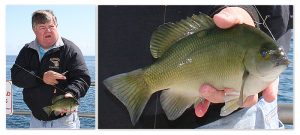
An opaleye I caught at the Cabrillo Mole
Shoreline: One of the main goals of rocky shore anglers in southern California.
Boats: An inshore species rarely taken by boaters unless targeting them at places such as jetties and breakwaters.
Bait and Tackle: Some anglers specialize in opaleye, and many of them swear that moss or frozen peas are the best bait. I’ve actually caught more on ghost shrimp but I must admit that I’ve watched, many a morning, while a group of opaleye “pros” from Los Angeles (I recognize them by now) caught opaleye after opaleye and they almost always use moss as their “bait du jour.” I think all three baits are excellent for opaleye (although the ghost shrimp are more expensive and sometimes hard to find). Fresh mussels, pile worms, bloodworm, and small rock crabs also make good bait. I also managed to hook a few opaleye using garden snails during an experiment testing different baits at Catalina in 2005.
Food Value: A very good eating fish that is mild flavored, small flaked, firm textured, and low in fat content. It is suitable for many forms of cooking but most commonly fried or steamed whole.
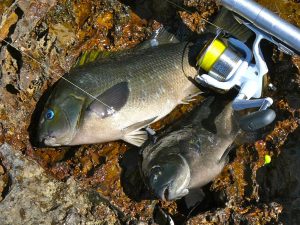
Opaleye caught from the rocks on the Palos Verdes Penninsula
Comments: Primarily herbivores (vegetarians), opaleye eat a variety of plants including feather boa kelp, giant kelp, sea lettuce and coralline algae. Evidently they also grab organisms attached to seaweed as they’re making their rounds, tasty little items like tube worms and red crabs. Opaleye are a favorite of many anglers; they’re hard to hook but once hooked put up a very good fight for their size.
The crystal-clear waters at Avalon present quite a challenge for the sagacious, line-shy opaleye. Big schools of 2-4 pound fish hang around the Green Pleasure Pier and the Cabrillo Mole but they can be very hard to catch. They seem more cautious of line at the Green Pleasure Pier but if you use a light line, perhaps 2-4 pound fluorocarbon, you might get them. (Actually, to be fair, I catch them every year at the Pleasure Pier and I usually am using 8-10 fluorocarbon). Of course the 1,794 ropes, tangled lines, pilings and yellow submarines that surround and hang under the GPP might also get your line.
At the Mole it’s the long fronds and blades of the giant kelp that sway (tidally) in or out near the railing. If the opaleye are allowed to encircle the kelp it’s pretty much over. As soon as they are hooked apply pressure and try to keep them coming toward you while having a person ready with a net. You need to use light line but can also pay the consequences if you’re unwilling to apply enough pressure.
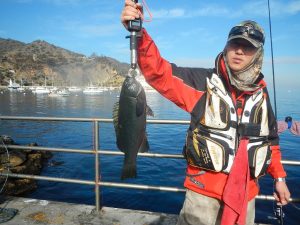
Big opaleye from the Cabrillo Mole
The opaleye “pros” who come over to Catalina from Los Angeles take the ferry over for one day, fish exclusively at the Mole, fish for one species—opaleye, and are almost always successful (coolers are crammed with fish). You learn from such experts and a few things should be mentioned.
The first is that the opaleye are typically at a mid-water depth, five to ten feet under the surface of the water depending upon the depth of the water. They are rarely caught on top and infrequently caught on the bottom (although I’ve caught several fishing on the bottom at night and they are often caught on the bottom by anglers casting out from jetties).
Second is that if you want to fish the correct depth a float is desirable and long slip-line floats are the preferred tackle for the opaleye hunters.
Third is when you see the float go down, strike and, as mentioned, try to keep the fish out of the kelp.
Fourth is that light line (preferably fluorocarbon) and small hooks (size 6 or smaller) are key.
Opaleye, especially the older, larger fish can be frustratingly difficult to catch. Chum with peas and a whole school may come up to check out the bait and fish after fish will approach the bait before turning away in seeming disapproval. But, the challenge of outsmarting the fish is part of the fun.
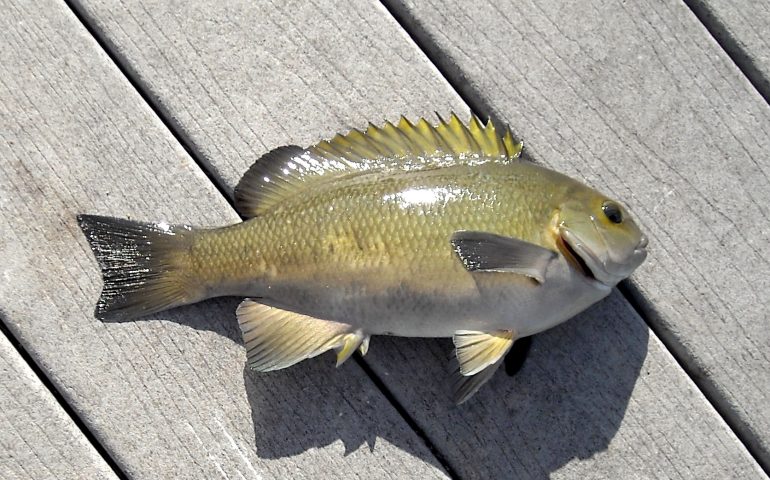
[…] Food Value: A very good eating fish that is mild flavored, small flaked, firm textured, and low in fat content. It is suitable for many forms of cooking but most commonly fried or steamed whole. Opaleye Pier Fishing in California […]
Many fishermen love opalye because they are difficult to catch but, if caught, fight quite hard for their size.
It’s been my hobby to go fishing with my friends. Is there a community i can join here?
Interesting read about opaleye! I’ve caught these before but never cooked them. Do you find their flavor pairs better with light citrus marinades or bolder herbs? Also, does their firm texture hold up well to grilling compared to other perch varieties? Would love to try a recipe with my next catch!
Share with interesting extracurricular activities. With the information you share, bring new knowledge values.
Definitely gonna try moss next time! Thanks for the info!
Never knew they were vegetarians.
Wow, this is a super helpful guide for opaleye fishing in California! I had no idea they liked moss as bait. Gotta try that next time I’m at the pier. Thanks for the tips!
Welcome to Games Hub – Play Free Online Games Instantly
Depending on the water depth, opaleye are usually five to ten feet below the surface. This is the first characteristic of mid-water.
Opaleye are such a challenge, but so rewarding! Moss and small hooks are definitely the way to go
Those secret spots for big opaleye in Avalon sound amazing! I’ve only caught small ones from piers.
It’s crazy how selective opaleye can be with bait! Always a fun puzzle to figure out what they want.
It’s a good spot to pause and learn about the many environmental elements that affect the bay’s health and the fisheries that depends on it.
It’s fascinating to learn about the opaleye and its diverse nicknames, like Jack Benny and button-eye! I didn’t realize how varied their appearance could be or that some have almost white coloring. The record sizes are impressive—especially the 13-pounder speared by David Williams. This reminds me of how catching rare fish in games like Bitlife can be a fun way to experience the excitement of discovery, just like real-life fishing.
I remember catching an opaleye, or Girella nigricans, during a fishing trip near Catalina Island. Its unique coloring really stands out in an aquarium, and the variety of names it goes by is interesting! When I’m not outdoors, I relax by playing Slope Game, which is a great way to unwind after a long day. Both activities help me appreciate the diversity in hobbies and nature.
The “cat distribution system” is a funny, internet-born term that describes how cats seem to randomly appear in people’s lives, as if the universe just assigns them to you when you least expect it. You didn’t plan to adopt a cat, but suddenly one shows up at your doorstep, in your backyard, or follows you home, and boom, you’re a cat owner. It’s like some invisible force decided it was your turn. People love this idea because it feels magical, spontaneous, and a little bit like fate (with fur).
this Opaleye guide is super helpful for my next pier fishing trip!
Sea Chubs, or opaleye perch, are a vibrant addition to marine life, boasting a plethora of names and a rich history in nomenclature. Their unique appearance and cultural significance reflect a diverse ecological tapestry. During a dive in California, I encountered a school of these stunning fish, reminiscent of a Block Breaker moment when unexpected beauty surfaces amidst the waves. Such encounters remind us of the ocean’s hidden treasures and the stories they tell.
Great post on Opaleye!
What a fascinating read! I had no idea about the ‘Opaleye pros’ or that they’re such a challenge to catch. Now I’m tempted to try for one myself.
Fascinating read—those opalescent blue-green eyes really do give the opaleye its name